
Concept explainers
The two blocks are released from rest when
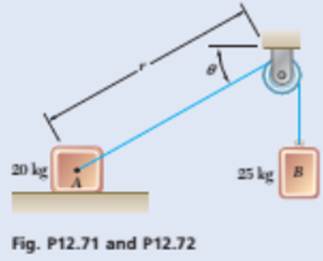
(a)
The initial tension in the cable.
Answer to Problem 12.71P
The initial tension:
Explanation of Solution
Given information:
Blocks are released from rest when
Mass of the pulley and the effect of the friction is negligible.
From part (b), The initial acceleration of block A:
Calculations:
From the free body and kinetic diagram of block A:
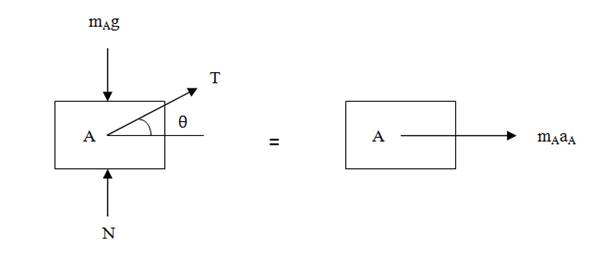
Conclusion:The initial tension in the cable is
(b)
The initial acceleration of block A.
Answer to Problem 12.71P
The initial acceleration of block A:
Explanation of Solution
Given information:
The figure:

Blocks are released from rest when
Mass of the pulley and the effect of the friction is negligible.
Calculations:
Draw the free body and kinetic diagram of block A:
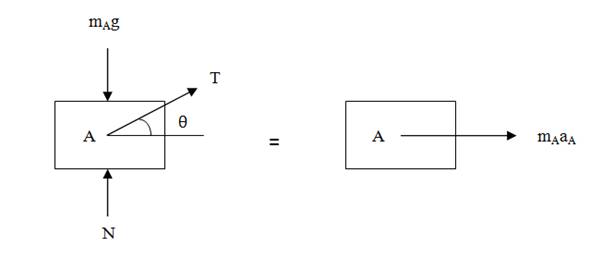
Draw the free body and kinetic diagram of block B:
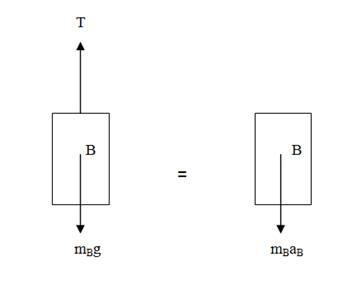
Representing the components of acceleration of block A as shown in the below diagram:
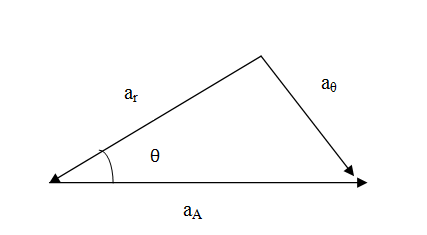
Conclusion:
(c)
The initial acceleration of block B.
Answer to Problem 12.71P
The initial acceleration of block B:
Explanation of Solution
Given information:
Blocks are released from rest when
Mass of the pulley and the effect of the friction is negligible.
From part (b), The initial acceleration of block A:
Calculations:
From eq. (6) defined in part (b):
Conclusion:The initial acceleration of block B is
Want to see more full solutions like this?
Chapter 12 Solutions
Vector Mechanics for Engineers: Dynamics
- B9 Please help on the attached question.arrow_forwardB7 Please help on the attached question.arrow_forwardFrom dynamics CHAPTER 12: Rectilinear Kinematics. Continuous Motion. Qu. 1 The velocity of a particle traveling along a straight line is v = (3t2 - 6t)ft/s, where t is in seconds. If s = 4ft when t = 0, determine the position of the particle when t = 4s. What is the total distance traveled during the time interval t = 0 to t = 4s? Also, what is the acceleration when t = 2 s?I want to show all work step by step problemsarrow_forward
- Z1 please help on the attached question.arrow_forwardProblem 3 (10 pts). When using linear shape functions to solve the multiphysics thermoelastic problem considered in class, we found that the stress in the rod is affected by unphysical oscillations like the following plot(a) [10pts] What is the origin of this issue and how can we fix it?arrow_forwardZ6 please help on the attached question.arrow_forward
- B2 Please help on the attached question.arrow_forwardA particle, starting from rest, travels along a straight track and for 14 s has an acceleration as shown. Draw the v-t graph that describes the motion and find the distance traveled in 14 S. a 8 11 уг (0.8) 11 ут (6,8 6. 4+ 2 *2 Ye (1.0) t 2 4 6 8 10 12 14 dre dec dec decarrow_forwardMechanical engineering,Use paper sheet. No chatgpt.arrow_forward
 Elements Of ElectromagneticsMechanical EngineeringISBN:9780190698614Author:Sadiku, Matthew N. O.Publisher:Oxford University Press
Elements Of ElectromagneticsMechanical EngineeringISBN:9780190698614Author:Sadiku, Matthew N. O.Publisher:Oxford University Press Mechanics of Materials (10th Edition)Mechanical EngineeringISBN:9780134319650Author:Russell C. HibbelerPublisher:PEARSON
Mechanics of Materials (10th Edition)Mechanical EngineeringISBN:9780134319650Author:Russell C. HibbelerPublisher:PEARSON Thermodynamics: An Engineering ApproachMechanical EngineeringISBN:9781259822674Author:Yunus A. Cengel Dr., Michael A. BolesPublisher:McGraw-Hill Education
Thermodynamics: An Engineering ApproachMechanical EngineeringISBN:9781259822674Author:Yunus A. Cengel Dr., Michael A. BolesPublisher:McGraw-Hill Education Control Systems EngineeringMechanical EngineeringISBN:9781118170519Author:Norman S. NisePublisher:WILEY
Control Systems EngineeringMechanical EngineeringISBN:9781118170519Author:Norman S. NisePublisher:WILEY Mechanics of Materials (MindTap Course List)Mechanical EngineeringISBN:9781337093347Author:Barry J. Goodno, James M. GerePublisher:Cengage Learning
Mechanics of Materials (MindTap Course List)Mechanical EngineeringISBN:9781337093347Author:Barry J. Goodno, James M. GerePublisher:Cengage Learning Engineering Mechanics: StaticsMechanical EngineeringISBN:9781118807330Author:James L. Meriam, L. G. Kraige, J. N. BoltonPublisher:WILEY
Engineering Mechanics: StaticsMechanical EngineeringISBN:9781118807330Author:James L. Meriam, L. G. Kraige, J. N. BoltonPublisher:WILEY





